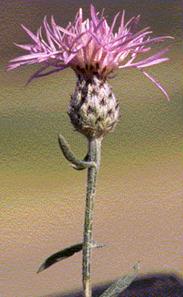Is this Plant a Weed, a Noxious Weed, an Invasive Weed, or a “Superweed”?

Spotted knapweed crowds out native species and forage for livestock. Photo courtesy of the USDA.
Is that plant crowding your crops just a weed? Is it a noxious weed? An invasive weed? A “superweed” that requires special attention? Many times these terms are used interchangeably, yet there are similarities and differences among them. To clarify them, the Weed Science Society of America has produced a fact sheet that reviews some basic terminology. This article summarizes these definitions.
Weed
The Weed Science Society of America defines a weed as a plant that causes economic losses or ecological damage, creates health problems for humans or animals, or is undesirable where it is growing. Examples of weeds in Montana are kochia (Kochia scoparia), common lambsquarters (Chenopodium album), and field pennycress (Thlaspiarvense). You can find information on how to manage agricultural weeds in Montana at the Cropland Weed Ecology and Management Extension website.
Noxious Weed
A noxious weed is any plant designated by federal, state or local government officials as injurious to public health, agriculture, recreation, wildlife or property. Once a weed is classified as noxious, authorities can implement quarantines and take other actions to contain or destroy the weed and limit its spread. Examples of noxious weeds in Montana include yellow starthistle (Centaurea solstitialis), rush skeletonweed (Chondrilla juncea), and tansy ragwort (Senecio jacobaea, Jacobaea vulgaris). More information on Montana noxious weeds can be found at the MSU Extension Invasive Plants website.
Invasive Weed
Invasive weeds are species that establish, persist and spread widely in natural ecosystems outside the plant’s native range. When in a foreign locale, these invaders often lack natural enemies to curtail their growth – enabling them to overrun native plants and ecosystems. It should be no surprise that many invasive weeds are also classified as noxious weeds by government authorities. The Presidential Executive Order 13112 prohibits federal agencies from authorizing, funding or carrying out actions likely to promote the introduction or spread of invasive weeds – unless the benefits clearly outweigh the potential harm. The order also mandates that all feasible and prudent measures be taken to minimize risk of harm. For example, saltcedar (Tamarix spp.) is an abundant invasive species in many counties in Montana and has been classified as a Priority 2B noxious weed. As such, management criteria requires eradication or containment where less abundant.
"Superweed"
While I personally do not like this term, it is common to hear "superweed" to describe plants that have evolved characteristics that make them more difficult to manage as a result of repeated use of the same weed management tactic. The most common use of the term refers to a weed that has become resistant to one or more herbicide mechanisms of action after their repeated use in the absence of more diverse weed control measures (i.e. herbicide-resistant weeds). For example, people have used this term to refer to kochia plants that are resistant to glyphosate and growth regulators.
Further Information
For more information see the Weed Science Society of America fact sheet (750KB PDF), the Weed Management section of the MSU Extension Cropweed Management resources page, or contact a cropweed specialist.
Originally published in the Spring 2017 issue of the Montana IPM Bulletin. Authored by Fabian Menalled, Extension Cropland Weed Specialist.
